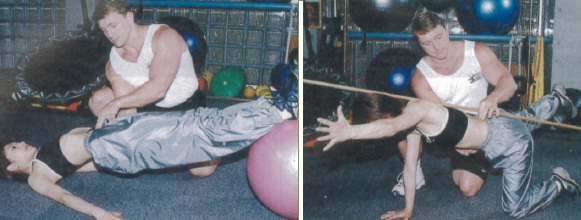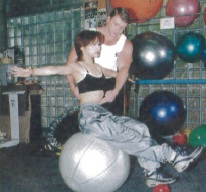Story by Katie Cork
Photos by Dov Friedmann
Anne is a mother with two young children who also works part-time as a community relations director. Always on the go, she finds little time to relax. She figures that running from one place to the next, carrying children, groceries and stroller keeps her relatively fit Recently the muscles in her lower back became so tense and knotted that even simple tasks, such as walking or sitting, resulted in sharp bursts of pain.
Jeremy works for a large international bank, putting in long hours at his desk five, sometimes six, days a week He rarely makes time to exercise, occasionally playing squash or visiting the gym when he has the time and energy. On weekends he likes to relax with a round of golf. He figures it’s good exercise after a relatively inactive week. Last year recurring back pain led to first a loss of performance, then a three-month absence from the golf course altogether.
It’s been proven that 80 to 85% of adults will experience back pain at some point in their lives. Be it aching, burning, gnawing, stabbing, twisting, throbbing or agonizing pain. Pain that causes the second-highest number of missed workdays. Pain that makes 31 million Americans spend $16 billion on doctors, chiropractors, acupuncturists, neurosurgeons, orthopedic surgeons and osteopaths. Amazon.com lists 330 books on preventing, coping with and treating back pain. Why does it remain such a common problem?
Because average persons take little notice of their back until it’s too late. Acupuncturist Dr. Gregg Sappers at the Helios Acupuncture Clinic in Nogizaka says back pain that appears seemingly overnight may actually have been building for a while. Bending down to pick up a dropped coin, for example, could just be the final straw. One of his patients experienced chronic back pain after a single sneeze.
Many cases could be avoided by paying a little more attention to posture and properly conditioning the most vital part of the body: the core.
Your Spine, Your Lifeline
The “core” consists of the body (trunk) and head, excluding the arms and legs. At the center is the body’s lifeline: the spine. A damaged spine, at the very worst, leads to paralysis; at the very best, a chronic or debilitating back pain. How well your spine is protected depends upon how well you condition your core.
The spine includes 24 separate bones—vertebrae. When viewed from the front or back, the perfect spine is straight; from the side it is “S- shaped.” The top of the “S” is the cervical spine, the seven vertebrae in the neck area that protect the spinal cord where it attaches to the brain. In the middle are the 12 thoracic vertebrae of the upper back. The lumbar spine, or lower back, consists of five vertebrae. At the bottom of the spine is a large, solid bone called the sacrum.
Between each vertebra is a shock-absorbing disc. Facet joints link vertebrae and also direct and limit the spine’s movement. Woven into the center of this stack is the spinal cord, the main highway of nerves transporting sensations and commands between brain and the body. Muscles, tendons and ligaments surrounding the spine form a strong, flexible and supportive structure.
If you endure long periods of inactivity at work, slouch or slump instead of sitting up straight, have a poor ergonomic environment, are overweight, carry heavy I bags or briefcases, or wear high-heeled shoes, you could be in for a bad case of back pain—if you haven’t had one already.
Likewise, if you’re emotionally stressed, walk with shoulders hunched and head forward, exercise sporadically but intensely or ski, play golf or tennis but don’t warm up beforehand or properly condition yourself. What happens to the back to cause pain? Muscles strain, sprain or spasm. Vertebrae or facet joints can present subluxation (misalignment) or dislocate. Nerves trap and pinch. Disks bulge, herniate or rupture. A vertebra can slip. Bones weaken and disintegrate (osteoarthritis, osteoporosis) or fracture.
Exercise and low-back expert Jeff Libengood, owner of Perfect Performance & Conditioning (PPC), says that 98% of all low back pain is mechanical, which means preventable and treatable through non-medical routes. The good news is that 90% of cases are resolved within three months. So nothing to worry about, right? Wrong! Three months is a long time, and living with often-constant pain can make you feel old, worried and depressed. Not to mention severely drain your bank balance as you seek treatment.
Prevention is Better than Cure
You’d be forgiven for thinking that all this doom and gloom means there’s no escape from the inevitable. While there’s no magic pill guaranteed to keep your back healthy for a lifetime, there is a way to minimize the risk of future back pain, or to stop it recurring.
Exercise. Whatever your lifestyle, however hard you work, make time for exercise that strengthens and conditions the core. Exercise improves posture, aids weight loss, increases flexibility and relieves emotional stress and tension.
A core-focused routine exercises the muscles that support and align the spine, and the stabilizer muscles of the body trunk. All body stabilization emanates from the core outward. A few sit-ups or crunches at the end of your workout are not core conditioning.
If you visit the gym, invest in a knowledgeable personal trainer to help devise an exercise pattern to improve stability, strength and flexibility. Yoga, Pilates and the Alexander Technique are popular and excellent ways to increase flexibility and improve posture. Everyone should warm up important muscles. For example, golfers should take a golf club and run the shaft across the shoulders. Maintaining a good posture, rotate the upper body to the right so that the shaft of the club is in front of you. Keep knees flexed and try to feel the upper body rotating against the resistance of the lower half. Then rotate to the left, keeping shoulders turning on a level plane rather than dipping and rocking. Ten minutes a day, on and off the green will reward you with a more comfortable and hopefully more successful game.
If you are turned off by exercise or are adamant that there is no time in your schedule to seek professional help or join a class, there are adjustments you can make to improve your back Poor posture is the number-one cause of low back pain. Make sure your ears, shoulders and hips are lined up. Distribute weight properly on both feet and stand up straight. Rounding the shoulders flexes the lumbar and thoracic spines, leading to excess low-back disc pressure and upper back kyphosis which will create a “dowager’s hump.”
Lose weight. Excess weight, especially carried in front, the so-called “beer belly,” pulls the lower spine out of alignment, creating excess lordosis, putting stress on the facet joints, discs and nerves. Find a chair that fits to encourage good posture. Sitting puts an extra 40% more pressure on the discs. An ergonomic environment at work and at home may help save you pain and money in the future.
How to Fix it
Most people turn to medicine for relief from back pain. Western medicine offers painkillers and, for extreme cases, surgery. Chiropractors help the body to heal itself without the use of drugs or medication, manipulating the muscles and spine using hands to remove pressure wherever the spine is out of alignment.
When western medicine fails, many try ancient eastern or Oriental practices, such as massage or acupuncture. Massage relieves muscular pains using pressure; acupuncture relaxes the muscles, inserting then manipulating needles using hands and heat. Electricity is also used to stimulate tense and knotted muscles.
There is no definitive explanation as to why acupuncture works, but it clearly does. Dr. Sappers recounts a story of a foreign ambassador to Japan who a few years ago pulled his back so badly that he was forced to lie under his desk for two days, unable to move because the pain was so intense. Three western doctors from three clinics could do nothing to stop the pain. After four hours of acupuncture, the ambassador was able to get off the floor and seek treatment in a more comfortable setting.
Painkillers, chiropractic medicine, massage and acupuncture can help to alleviate pain caused by muscle strain, but they do not address the fundamental cause of the problem. Exercise is often the last thing on a back-pain sufferer’s mind. Although rest gives immediate relief, studies show that more than a couple of days can be detrimental to recovery and lead to muscle atrophy and increased pain. With proper conditioning and a few modifications in lifestyle, you can put back pain behind you.
Jeff Libengood of PPC contributed to this article.
Helios Acupuncture Clinic, Tel: 3403-3272
Perfect Performance & Conditioning Ltd., Tel: 5786-1068












